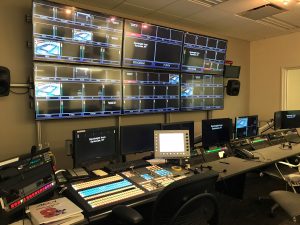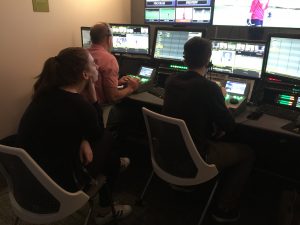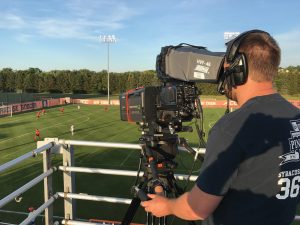A Strong Foundation Keeps Syracuse University Ahead of the ACC Network Curve
Joint effort with the communications program pushes the department forward
Story Highlights
Although the cold weather is at its peak in central New York, productions at Syracuse University are heating up in the months leading up to the launch of the ACC Network. While other ACC members have put their hard hats on and rolled up their sleeves for extensive overhauls, Senior Producer Scott Hecht, Broadcast Engineer Tom White, and company are in an advantageous situation through work done in the past.

Control Room PCR-A houses a Ross XPression graphics, an Evertz DreamCatcher, and a Lawo mc256 audio console.
“We’ve been lucky because, while many schools had to start from the very beginning, we had the brick and mortar already in place,” Hecht says. “The forward thinking of this university has got us to the point where we are right now.”
The Backbone
When White arrived at Syracuse in July 2017, the university was months into a connectivity overhaul. After the construction was completed, 338 strands of fiber (228 stemming from the Carrier Dome) had been laid to connect seven facilities to the program’s central nervous system, the S.I. Newhouse School of Public Communications. For one venue in particular, the Drumlins Country Club, White developed a flypack to produce a broadcast via IP for tennis productions.
At a university that fields 18 NCAA Division I teams, things can become a bit hectic. Despite the busy schedule, the department comprises only Hecht, White, Operations Manager Jim Hamilton, and producer Kristin Hennessey. On game day, the core four rely on a staff of mostly freelance workers.
“These are all people that Tom has worked with for many years in this market and brought them over [to Syracuse],” Hecht says. “I think that allows us to execute some shows at a higher degree since there isn’t as much teaching. We would love to have more students and get more students, but we play with what we have right now.”
For a staff of four backed by freelancers, Newhouse doubles as headquarters and access to more help.
“The Newhouse staff is an integral part of our operation,” White explains. “The leadership of Neal Coffey [manager, operations and engineering, Dick Clark Studios, Newhouse School] has brought us along very nicely because they provide the engineering support for shows and accommodate our needs right away. It’s a win-win for Newhouse and our operations because we provide an opportunity for students behind and in front of the camera. We couldn’t do this without them.”
The Cogs of the Machine
The program runs a majority of its operations out of the master-control room (PCR-A). Although the heavy lifting is delegated to this lead control room, the facility houses extra control rooms both as backup and to educate production students.
“We primarily use PCR-A for both linear and digital. [The other two control rooms] are there if we want them,” says Hecht. “Since it’s the School of Communications, they’re teaching classes and doing things in those rooms but also contributing to our programming with halftime and studio content.”
Along with two additional control rooms, Syracuse has a full complement of tools in the field and in-house to capture the action. The arsenal includes six Ikegami HDK-95C cameras, with FA-97 fiber adaptors, and four Marshall POVs. The Ikegamis are atop Cartoni tripods and are equipped with a variety of Fujinon lenses: two 77X9.5, two 55X9.5, two 18X5.5, and one 23X7.6. A Multidyne SHED also accompanies each camera.
The broadcast facility in Newhouse features a Ross Vision production switcher, an Evertz 180×180 router, an RTS Adam intercom with Omneo, and a Lawo mc256 audio console. Like fellow members of the ACC, Syracuse is also deploying a 16-channel Evertz DreamCatcher and three Ross XPression graphics systems.
A committed crew and the latest technology help Syracuse overcome the obstacles of the daily grind, but the secret to a successful broadcast comes before the red light comes on. On the production side, Hecht opines that experience is a key driver to a successful show.

With the ACC Network launch in August, Syracuse is on pace to surpass more than 100 productions in 2019.
“Tom takes care of everything at the venue while [my team and I] take care of everything in the control room with Neal and his group. It’s a well-oiled machine,” he says. “We run it like we did in the TV truck for all of those years.”
From a technical perspective, White is always tinkering and planning. “Jim and I will go over [to the venue] and test the fiber lines,” he says. “On days when we’re not doing a shoot, I spend it prepping.”
Putting the Cherries on Top
2018 ended with 98 live event and studio productions, but, with an increased workload coming in 2019, the program is expecting a total that passes the century mark and hovers close to 120. With a proven infrastructure, a dedicated team, and a full slate of programming in place, Syracuse Athletics is primed for further expansion. And, with equal support from the network and the university, the future is bright for the Orange.
“[Tom and I] have been able to lead this project in a lot of different ways because of the talented people that we have here,” says Hecht. “The fact that [ESPN] doesn’t have to come in to micromanage us speaks volumes to where we are. The best is still ahead of us.”
CLICK HERE to check out more SVG coverage of ACC Network Launch Day.

